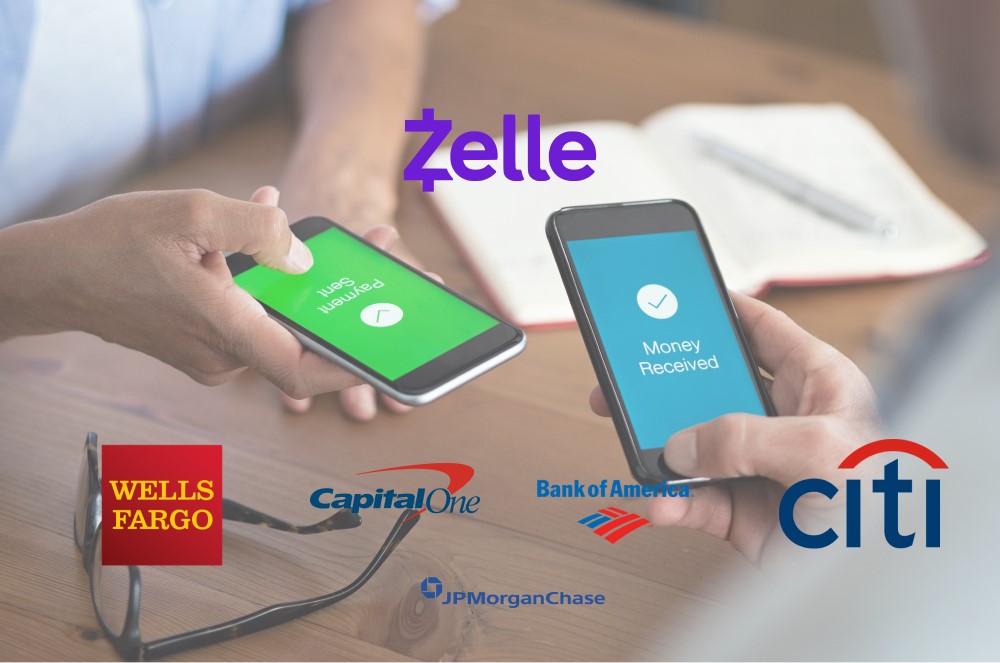Zelle Pay: When Traditional Banks Team Up Against New Disruptors
In this 4.0 era, it is common that traditional competitors band together to create a platform that challenges tech disruptors in their industry. In the finance industry, several competitors accomplished just that with the creation of Zelle, a peer-to-peer payment service led by Bank of America, Wells Fargo, JP Morgan Chase, and others. All told, Zelle includes participation from some 30 financial institutions.
At last, PayPal-owned Venmo has finally met its match: Zelle. In an effort to disrupt the peer-to-peer (P2P) payment market, major banks have built this platform that allows for speedy and secure money transfers directly to and from consumers’ bank accounts.
Zelle: The Real-Time Venmo Competitor Backed by Over 30 U.S. Banks

Zelle is a US-based money transfer service available to those who have a US bank account. It’s operated by a company called Early Warning Services LLC, which, in turn, is owned by a handful of large banks, including Bank of America, BB&T, Capital One, JPMorgan Chase, PNC Bank, US Bank, Citibank, and Wells Fargo. In addition, 400+ “member” banks and credit unions participate in the Zelle service.
The Zelle service was launched in 2017. There was an earlier version of the service called clearXchange going as far back as 2011, but accounts for personal money transfers were deactivated by December 2017 and users were encouraged to move to the Zelle service.
Why Leading Banks Co-Invested in Zelle?
After watching Venmo eat up their market and complete transactions for their customers, the big banks decided enough was enough. In 2011, Bank of America, Wells Fargo and JPMorgan Chase teamed up to work on a digital payments solution that would allow their customers to send money to each other. With eventual cooperation from more than 30 of the leading financial institutions in the United States and the world, Zelle is now set for the head-to-head battle with Venmo.

Zelle is basically a service started by banks, for banks. So, unlike its competitors such as Venmo or PayPal, each member bank has a lot of control over how to offer the service and whether (or how much) to charge for the service. While there is an independent Zelle app, for most users, the service is typically accessed through a bank’s website or mobile app. To sign up for the service or initiate or manage transfers, you log on to your banks’ website or app and access the Zelle service through tabs on the website or in the app. As a result, security features for the service depend on your bank’s security features.
While banks have always had the means to offer instant transfers, the current system required that customers have the account and routing numbers for the associated accounts. Zelle, meanwhile, is meant to offer a simpler method – like today’s popular payment apps, Zelle users only have to know information like a person’s phone number or email.
ACH Technology: The Powerful Zelle Network
You may wonder: “Is Zelle payment app built on blockchain technology? If not, what technology did they use to access the public ledger?”
In fact, Zelle does not use the blockchain. It runs on top of the ACH (Automated Clearing House) network, an electronic network for financial transactions founded in 1972. Zelle attempts to improve on ACH with features such as near-instant transactions. It does this by taking on more risk, with the tradeoff of low transaction limits. There is no public ledger involved in any way. Zelle is purely a way to make consumer bank-to-bank payments. It’s essentially an electronic check that is settled between the two banks.
Unlike many other money transfer services where you might have to wait up to three days to finalize a transfer, a Zelle transfer can be completed within minutes, and the money can be available for you to use immediately thereafter. This is possible because the banks that offer Zelle are “member” banks and presumably such banks have been vetted and given a greater degree of trust, so they release the money faster.

In reality, the service works like this:
- Amy initiates a transfer of $100 to Beth through Amy’s banking app or web portal.
- Amy’s bank debits $100 from Amy’s account, sends a message through the Zelle Network to Beth’s bank that $100 is being transferred, and moves $100 to a settlement account.
- Beth’s bank notifies Beth of the transfer, credits Beth’s bank account for $100, and messages Amy’s bank through the Zelle Network that the money has been credited.
- The banks then settle the account through an ACH transfer, which happens at specific times of the day during bank workdays.
List of supported banks includes the following (in alphabetic order): Ally Bank, Bank of America, Bank of Hawaii, Bank of the West, BB&T, BECU, Capital One, Citi, Citizens Bank, Comerica Bank, ConnectOne Bank, Dollar Bank, Fifth Third Bank, FirstBank, First Tech Federal Credit Union, First Tennessee Bank, First National Bank, Frederick County Bank, Frost Bank, HomeStreet Bank, JP Morgan Chase, KeyBank, M&T Bank, MB Financial Bank, Morgan Stanley, PNC Bank, SchoolsFirst Federal Credit Union, Star One Credit Union, SunTrust Bank, TD Bank, USAA, U.S. Bank, and Wells Fargo.
To make the system work, Early Warning also has strategic partnerships with top payment processors in the banking industry, including CO-OP Financial Services, FIS, Fiserv, and Jack Henry and Associates. These agreements, it says, will help to expand Zelle to community banks and credit unions going forward.
With Zelle, the goal is to take the existing clearXchange network and make it known to consumers, who – as with Venmo – will only need to know a person’s phone or email to use it. Like Venmo, Zelle is meant for the same sort of quick, personal payments – like splitting the dinner bill with friends or roommates collecting utility and rent money from one another.
“Fragmentation has been frustrating for consumers. Inconsistent experiences have made it difficult to send and receive money between banks,” said Paul Finch, Chief Executive Officer, Early Warning Services, in a statement about Zelle’s launch. “Zelle unites the financial community behind a single, real-time P2P payments experience for millions of consumers,” he adds.
“Together, we are removing friction from finance, allowing money to move seamlessly between accounts in minutes. This revolution in money movement will create for consumers a viable alternative to checks and cash.”
Zelle Vs. Other Mobile and Digital Wallets
Zelle was set up by the big banks to compete with mobile and digital wallets like Venmo and Cash App. There are differences between the services, and one of the main ones is that, with Venmo and Cash App, there’s an extra step to get the money into your bank account. The root of the advantage that Zelle has over Venmo is its obvious connection to the financial institutions that its customers use.
When completing a money transfer using Zelle, a customer uses their usual mobile banking app, executes the transfer, and the money almost immediately appears in the receiving party’s bank account. Venmo, however, doesn’t work as quickly; while the transactions happen immediately within the Venmo network, the money goes to the receiving party’s Venmo “wallet,” which then must be manually deposited into their bank account, a step that can take days.

Zelle’s direct link to financial institutions doesn’t only supply customers with quicker access to their money; it also supplies an added sense of security. By being able to complete all P2P transactions within their mobile banking apps, customers will avoid giving their banking info and passwords to a third party.
“You don’t have to give your ABA number and your routing number…to some third party. You don’t have to give your username and password credentials to some third party. It all happens in a much more secure way inside your bank app.” – explained by Aditya Bhasin, CIO, Head of Consumer Technology, Wealth Management Technology & Operations at Bank of America.
Other than this main difference, as already mentioned earlier, Zelle allows each member bank a great deal of control over how to operate the service and how much, if any, to charge for the service. In other words, if you have several Zelle accounts at different banks, you’ll have to pay attention to the differences between the services in order to not encounter any surprise charges or daily/weekly/monthly transfer limits.
Zelle’s Business Model: “United We Stand, Divided We Fall”
When a new enterprise disrupts an industry, incumbent companies typically look internally for competitive solutions. Often, corporate innovation relies on an internal unit working with consultants on a new project. This strategy can and has worked, but is prone to delays and setbacks.
If the industry disruptor is a platform business, its explosive growth robs competitors of the time needed to design and execute a new business strategy. In the age of platforms, innovation strategies must develop more quickly. To achieve that, corporate leaders need to change dogmatic thinking both internally, and in some cases, externally, to convince traditional competitors to temporarily work together to compete against a common rival: the new disruptor.
The task of uniting former competitors is daunting, but Zelle provides a roadmap for how to go after low-hanging fruit to create a wildly successful joint venture. In 2018, Zelle surpassed its PayPal-owned competitor Venmo in payments volume. Let’s dive into how Zelle was structured to provide one example of how traditional competitors can band together to fight back against disruptors and/or monopolies.
Focus on Relationship Building
The biggest challenge to industry collaboration is the first one innovation champions will confront: dogmatic thinking around competition.
At the Boston College Chief Executives Club, Applico CEO Alex Moazed asked Bank of America CEO Brian T. Moynihan about his role in the creation of Zelle. Brian Moynihan responded by saying,
“I had to work with the industry more, with the other CEOs, to say we’re going to do it. That’s something that’s been interesting over the last 5 to 7 years with some of the banks. We basically sit there and say we got these big issues, so we’ll put it [a collaborative solution] together to solve it. Zelle was an application of that.”

Industry leaders in any industry frequently meet at conference and private executive lunches and dinners to talk about trends and challenges in the industry. Traditionally, executives take note of opportunities and challenges to take back to their organization for their teams to solve. As Brian Moynihan described, his job wasn’t just to direct his own team within Bank of America but also to get other CEOs on board for a cross-industry project.
A true change agent who sees an opportunity for industry collaboration continuously moves the conversation in that direction. The conversation will flow more smoothly if there’s an existing technology that can be identified and leveraged into a new platform.
Distributed Ownership
In 2015, clearXchange was combined with Early Warning Systems, which offered a fraud detection, risk management, and authentication service. Early Warning Systems currently owns Zelle. Early Warning Systems itself is owned by Bank of America, BB&T, Capital One, Navy Federal Credit Union, JPMorgan Chase, PNC Bank, Ally, US Bank, and Wells Fargo.
Notice that while 30+ financial institutions participate in Zelle, only 10 own the entity itself. With just a handful of players, the banks had enough clout and resources to build a competitive platform that other banks couldn’t ignore. An upside to being an early adopter of platform collaboration is the ability to own a piece of the pie. That ownership pie often won’t be shared among the entire industry, just among those with the vision to collaborate from the start.
The Platform Must Continuously Evolve
Zelle’s achievement speaks for itself, and the story of how it came to be provides a blueprint for other industries who find themselves similarly threatened, such as Amazon Business’s threat to B2B distributors.

However, Zelle might not be a perfect model for how to build a collaborative platform.
If Zelle’s leadership is vested and truly empowered to take risks, and – if necessary – seek funding elsewhere, then the app could capitalize on its best ideas, fail on its worst, and leap further ahead of Venmo.
The banks that control Zelle can either commit additional capital like a venture capital firm, or they should allow external shareholders to invest in Zelle. Why? To free Zelle to doggedly pursue its revenue potential. Zelle is not currently a revenue generator for the banks that own it. But it could be.
By tying Zelle’s executive pay to the long-term revenue-generating capability of Zelle, incentives better align between Zelle’s management and shareholders. The banks would need to commit capital upfront to create a 10-20% employee stock pool. But, if the bet pays off, when the banks buy back the stock pool in 5+ years, Zelle will be valued at much, much more than it is today.
Bottom Lines
Currently, Zelle does a decent job of keeping pace with Venmo. However, its ability to surpass Venmo largely came from its ability to convert existing bank clients to Zelle clients. That internal pool of users has a cap. Meanwhile, Venmo attracted its large user base from scratch.
Moving forward, Venmo will continue to evolve, and Zelle will need to find ways to attract new customers as well if it hopes to maintain its small lead over Venmo. The challenge for Zelle is the banks’ stranglehold on its capital, both financial and human. Corporate innovation must be spun out into its own entity with vested executives that are free to pursue additional funding and experiment with new revenue streams.








